500 artists showcased their work in Brooklyn this weekend
By Oona Milliken | omilliken@queensledger.com
Arts Gowanus hosted their sprawling “Open Studios” art fair across Gowanus featuring more than 500 artists in 90 plus locations from 12-6 on Saturday, Oct. 21 and Sunday Oct. 22nd. Open Studios allows visitors to come into artist’s studios, view their work, see what their spaces look like and purchase pieces directly from the artist without going through a gallery or a museum. With artists showcasing work of all mediums, this year’s crop had a life-size clay doll, abstract paper art, glass oysters and artists from the Fulton Art Fair, which primarily consists of Black American artists. Gowanus is also hosting a fundraiser for artists whose studios were affected by the flooding on Sept. 29 at their headquarters at 540 President Street in Gowanus. Emily Chiavelli, the Programs Director for Arts Gowanus and a Brooklyn artist herself, said pulling off the festival, which grows every year, was always a feat. This year, Chiavelli said Arts Gowanus also wanted to support the artists whose work had been impacted by the rising floodwater.
“Gowanus always gets hit really badly by flooding, there’s the combined sewer and the canal and all this sort of stuff that bubbles up. 540 President Street where I mentioned our headquarters was hit very very badly and all the studios are below grade. There was just water pouring through the doors, like some artists had like 16 inches of water, 14 to 16 inches,” Chiavelli said. “A lot of people lost a lot of stuff. A lot of irreplaceable stuff, which is the most devastating part, completed work.”
Hannah Robinett, an artist whose studio sits in the basement of 540 President Street, is a conceptual artist whose screen printing, drawing and murals works were particularly damaged by the water. She said she had to get rid of around $2,000 worth of supplies that were ruined. In response, Robinett created a piece of art under her series “Order and Chaos” that was made from artworks that had been waterlogged.
“I had about 12 inches of water in my studio, so any supplies I had on the ground were ruined. It wasn’t just water, it smelled really bad, a bit like sewer water,” Robinett said. “I tried to use it for a lot of my work. I have a series called “Order and Chaos” where I create new works from old works that then come to fruition. I lost about 10 pieces in that flood, and I recreated a piece from it.”
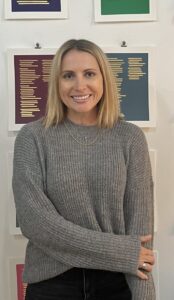
Hannah Robinett in her studio. Photo credit: Oona Milliken
Robinett said she appreciated the camaraderie of Arts Gowanus and loved working in a space with so many creative people. Particularly, she said the Open Studios was an important event because it allowed people to see how artists worked on a daily basis.
“This space is so awesome because there are so many different creatives and artists in this space. I’m with artists in the community,” Robinett said. “Arts Gowanus puts on Open Studios every year which is especially great because people can actually come in and see what I’m working on, what other artists are working on, and it often leads to connections down the road and being able to see people face-to-face, not on Instagram.”
At another studio on 540 President Street, Michael Potecha, an artist who primarily makes glass and ceramic sea molluscs such as oysters and mussels, said he was inspired by the beauty of the creatures and wanted to recreate them. Potecha said he was also inspired by non-profits attempting to bring back oysters into the natural ecosystems of New York. Potecha’s studio also had a station with the real thing and was passing out oyster snacks to visitors.
“Growing up in New York, I’ve always eaten oysters. But the real interest came from thinking of them as socio-symbolic symbols,” Potecha said. “The Billion Oyster Project is a non-profit that’s trying to improve the ecosystem of the Hudson River area, using oysters as a natural filter feeder and clean [the Hudson] that way.”
At 197 Bond Street, the Fulston Art Fair was doing Open Studios a bit differently. A lot of the artists in the collective, primarily Black Americans, are based outside of Gowanus and decided to come together to showcase their work in a group show. Althea Sapp Jimenez, who has been a part of Arts Gowanus for about five to six years, said it was important to create communities of artists. Jimenez said the Fulton Art Fair was especially meaningful because it allowed Black artists to support each other in their work.
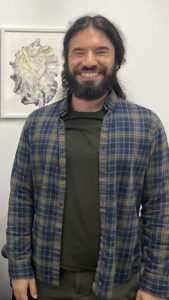
Michael Potecha in his studio. Photo credit: Oona Milliken
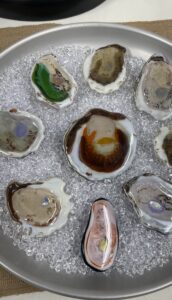
Potecha’s sample of glass moluscs. Photo credit: Oona Milliken“[The Fulton Art Fair] is an African-American Gallery group, it’s been around for 67 years, it’s influenced African-American people from all cultures, all backgrounds, we reach out from one side of Brooklyn to another,” Jimenez said.
Jimenez said her own work was inspired by the people she saw on a daily basis, the faces of people who were missing from the arts when she was growing up.
“Growing up, born and raised in Brooklyn, we never seen art of color, like we go to the museum and we see Van Gogh, but we never seen artists of color, really, unless you go out of your way to do that,” Jimenez said. “My inspiration is what I see every day, how it reflects every day.”
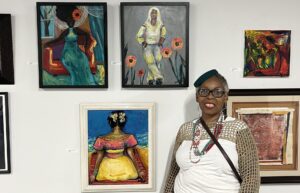
Aleathea Sapp Jimenez in front of her art pieces at 197 Bond Street. Photo credit: Oona Milliken
Syma Debbane, a ceramics artist whose studio at 184 Lorraine Street overlooked the location where she fired her art pieces, said she was inspired by ancient magical belief systems. One of Debanne’s largest works was a life-size clay replica of herself as a palm reader. When plugged in, Syma’s twin uttered prophecies for visitors to the studio.
“I’m inspired by ancient magical belief systems, mythologies and ancient artifacts,” Debanne said. “Egyptian, African, Mesopotamian…they really believed that if you could see it, if the artwork showed it and people looked at it, then it would come to be. Jewelry was not just body adornment, it was magical.”
Debanne said she wanted to preserve some of that magic in the modern world and hoped that her work reflected a sense of mythology. She said that the Open Studios event was an inspiration for her because it brought people to her work that might not otherwise come into her studio. Debanne also said appreciated Arts Gowanus for all the work that they did to support artists in the area.
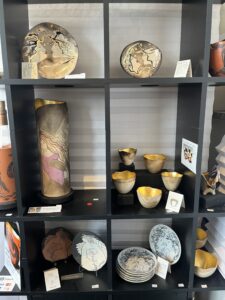
Syma DeBanne’s pottery. Photo credit: Oona Milliken
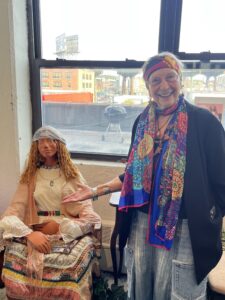
DeBanne with a clay replica of her younger self. Photo credit Oona Milliken
“I think it’s important for us to be able to share our process. The questions people ask often lead me to new work, and sometimes answering questions helps me understand what I’m doing,” Debanne said. “Arts Gowanus, they help us so much connect with each other. They help us have a visibility, I think there’s a lot of myths about artists that can get rewritten, a lot of stories about artists that can be updated, and [Arts Gowanus] helps us do that.
Next year, Open Studios will return for its 30th time. Chiavelli said it was important to keep the fair going as it brought attention to all the artists in the area.
“Open Studios, our whole mission is to keep the neighborhood sort of equitable and accessible to artists and keep creatives here, especially ahead of the Gowanus rezoning,” Chiavelli said. “This is sort of a major way we get visibility for all the great work that’s happening here.”


